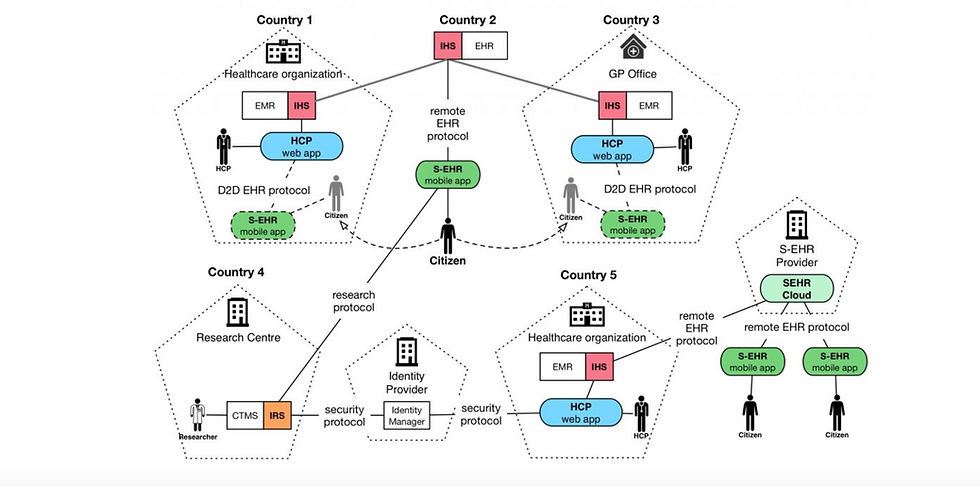InteropEHRate: enable patients to be in full control of the use of their health data
- Lloyd Price
- Mar 26, 2021
- 4 min read

InteropEHRate enables patients to be in full control of the use of their health data. Through Smart EHR (S-EHR), InteropEHRate leverages a set of new communication protocols for secure and cross-border exchange of health data. An S-EHR (also called S-EHR App) may securely store the health history of a person on his or her mobile device.
S-EHRs can communicate with applications of health care providers and researchers of different countries via highly secure channels of two kinds: local (based on a Device-to-Device protocol that does not use the Internet), remote (using Internet-based protocols).
At people’s choice, an S-EHR App may be complemented by the usage of an S-EHR Cloud service for preserving personal health data also on a cloud repository managed directly by the citizen. Health data are sent to the S-EHR Cloud in an encrypted format so that the health information is hidden to the Cloud provider.
An S-EHR supports the following communication protocols:
D2D (Device to Device) protocol: Exchange of data between patients and healthcare organizations without an internet connection.
R2D (Remote to Device) protocols: Three protocols for remote access: (1) to EHRs for citizens and to optional S-EHR Cloud for (2) citizens and (3) healthcare providers.
RDS (Research Data Sharing) protocol: Sharing of health data with research centres without cloud storage.
Research data sharing scenario
This scenario shows how citizens can share health data with research centres without cloud storage enabling decentralised clinical trials.
The research centre of the Regional University Hospital conducts a research study about the incidence and risk factors for a medical condition in the general community. The research protocol requires the prospective collection of anonymised health data for 2 years after the patient enrolment and a 5-year retrospective evaluation of his data before enrolment.

Mrs Eve, a patient with chronic hypertension, has learned through an advertisement campaign (e.g. a flyer she found in the waiting room of her family doctor), that the Regional University Hospital is conducting a study called “Side effects from hypertensive medication study” using the InteropEHRate format.
Being altruist by nature and since she is using an S-EHR app already, thanks to the QR code of the flyer informing about the study and that the S-EHR app is able to read, she finds out more information about the research and in particular the kind of data requested for the research. The S-EHR mobile app compares the health data stored by the app with the enrollment criteria of the study and after a positive match, Eve accepts the invitation called “Side effects from hypertensive medication study” and signs the consent form with its smartphone.
The research protocol requires sharing the health data of her previous 5 years and for the next 2 years, restricting their use only to that specific research protocol. Eve is asked to fill a questionnaire on self-reported side effects from antihypertensive medications.
A few months later Eve complained of nausea probably related to the assumption of the antihypertensive medications. Eva opens her S-EHR app and accesses the questionnaire of the research protocol, compiling the questionnaire with the symptom. The questionnaire is sent to the University Hospital conducting the research. If nausea doesn’t disappear, Eve will withdraw her participation in the research since she can do that at any time. In the case of withdrawing, the event is notified to the Research Centre of the University Hospital.
Infrastructure Building Blocks: software components and interfaces to be specified and/or prototyped by the project
The project will release an open specification for allowing different S-EHRs, of citizens, and different applications, of researchers and HCPs of different countries, developed by different vendors, to securely exchange health data using the InteropEHRate protocols. To facilitate the creation of a new ecosystem of applications based on this open specification, InteropEHRate will also release a reference implementation of the following key elements:
S-EHR mobile app: the prototype of a S-EHR, i.e. of a personal mobile app able to store in a secure way any health data about a single citizen, produced by the citizen itself or by the HCPs. The S-EHR mobile app will be able to exchange health data with HCPs and researchers of different countries using the InteropEHRate protocols.
S-EHR cloud: the prototype of a service, managed directly be the citizen, able to store on the cloud the personal health data of the citizen, collected by the S-EHR mobile app. A citizen may choose to use the S-EHR mobile app without using the corresponding S-EHR cloud.
InteropEHRate Health Services (IHS): a set of service components, reusable by any healthcare organization, offering the implementation of the InteropEHRate protocols for the exchange of health data between S-EHRs and HCP Apps, i.e. between citizens and HCPs. The IHS will exploit existing infrastructures for cross border identification of citizens and will assure the respect of strong security requirements.
HCP Web App example of a typical application exploiting the IHS and used by Health Care Professionals to read from and write on the S-EHR of their patients, with their consent, any relevant health data.
InteropEHRate Research Services (IRS): a set of service components, reusable by any research centre, offering the implementation of the InteropEHRate protocols, for demanding to the citizens and receiving from their S-EHRs, health data donated for research purposes.

This project has received funding from the European Union’s Horizon 2020 research and innovation programme under grant agreement No 826106.
Source: https://www.interopehrate.eu



















































Comments